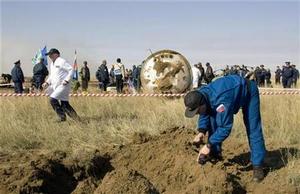Russian space officials denied a newspaper report the three crew returning from the International Space Station came close to death during Saturday's re-entry.
The Soyuz-TMA capsule with South Korea's first astronaut Yi So-yeon, U.S. commander Peggy Whitson and Russian flight engineer Yuri Malenchenko made a much steeper than usual "ballistic" landing.

|
| ©REUTERS/Shamil Zhumatov |
| A ground crew member checks radiation levels near the Soyuz capsule after it landed in northern Kazakhstan April 19, 2008. |
It subjected them to twice the gravitational forces experienced in a normal landing and took them nearly 300 miles off course. They were unhurt when rescue and recovery teams reached them.
"An investigation has been ordered into what really happened," a Russian space industry official, who did not want to be identified, told Reuters. "If there was a ballistic landing, something must have happened."
A ballistic landing is when a craft lands with a much steeper trajectory than usual and can involve emergency situations.
The previous landing of a Soyuz spacecraft in October, which brought Malaysia's first astronaut Sheikh Muszaphar Shukor back from space, was also bumpy. The space capsule veered some 200 km (120 miles) off course after a computer glitch.
Kommersant business daily, citing a space industry source, said the crew could have been burnt alive in the latest incident because the capsule entered the atmosphere at the wrong angle.
Shuttle Missions
Russia's state space agency Roskosmos dismissed the newspaper report as "erroneous".
"Publications of this kind are designed to disrupt a Russian-U.S. agreement on NASA's purchases of Progress and Soyuz spacecraft after (U.S. space) shuttles stop flying to the ISS," Roskosmos spokesman Alexander Vorobyov told Reuters.
Russia's Soyuz manned spacecraft, and the Progress cargo vehicle, have been the main workhorses serving the ISS since the space shuttle Columbia disintegrated on re-entry in 2003. That prompted NASA temporarily to suspend shuttle flights.
NASA plans to fly 10 more shuttle missions to construct and supply the ISS before the fleet is retired in 2010.
A second Russian space source who was at the landing site said the capsule looked more charred than usual because its engines were fired to soften the landing, igniting the dry grass in Kazakhstan's steppe.
"Otherwise (the media reports) are nonsense," he said.
Soyuz and Progress spacecraft, derived from the Cold War-era R-7 intercontinental ballistic missile, have been launched more than 1,700 times, demonstrating 97 percent reliability.
In April 1967, Soviet cosmonaut Vladimir Komarov died after the strings of the parachute intended to slow the descent of his Soyuz-1 tangled and the spacecraft hurtled to the ground.
In June 1971, the Soviet space crew of Georgy Dobrovolsky, Vladislav Volkov and Viktor Patsayev died from decompression as they were returning from space aboard another Soyuz capsule.



Reader Comments
to our Newsletter